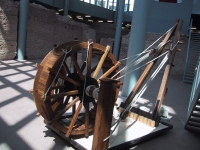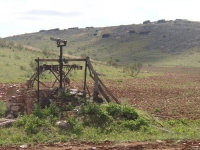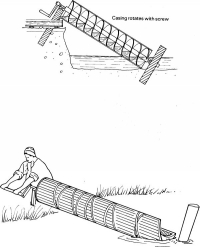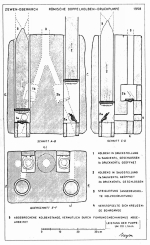



This model of a wooden crane was photographed in the Cattle-markt Thermes in Trier (Germany).
What is missing here is a (wooden or) metal trough just over the middle of the big wheel to catch the water and the conveying pipe(s).
It consists of a screw inside a hollow pipe. The screw is turned usually by a windmill or by manual labour. As the bottom end of the tube turns, it scoops up a volume of water. This amount of water will slide up in the spiral tube as the shaft is turned, until it finally pours out from the top of the tube and feeds the irrigation systems. (from Wikipedia)
Lifting and Water lifting apparatus
The five powers of Hero (c. A.D. 62) were the windlass, level, pulley, wedge and screw. According to O'Conner (1993:47), to this list should be added the roller, wheel, axle and the gear or toothed wheel. The oldest are the wedge, roller, wheel and the axle. The wheel and axle is believed to have been in use by 3000 B.C. (O'Conner 1993:47), and the wedge and roller some time before that. By 2000 B.C. the Egyptians where using levels, sledges, rockers and rollers in quarrying. They also used a windlass that applied tension by the twisting of multiple sets of ropes.A windlass is a lifting device. It consists of a drum on a horizontal axle which is anchored against displacement. A rope from the drum is tensioned by rotating the drum using some form of grip like handspike or lever. This type of windlass, as well as the pulley, was known to Aristotle. The screw is usually attributed to Archimedes, but may have actually been invented earlier by Archytas of Tarentum (O'Conner 1993:47). The Romans made cranes that made use of the windlass to lift heavy objects (Landels, 2000:85).
The most primitive gear is the toothed wheel. This was used, for example, by the Egyptians for lifting water by transforming rotation about a vertical axis to rotation about horizontal axis. It has been attributed to Archimedes. There is some evidence for this, it certainly appeared at about his time. It is unclear if the Romans used toothed gears in the construction of the aqueducts, but one can speculate that they may have been components of other machines. A modified toothed wheel, called a ratchet, was probably used to ensure movement in only one direction.
More complex gear systems are discussed by Hero and Aristotle. In Problem 11 of his Mechanical Problems Aristotle describes the roller.
... on the rollers there is no friction at all, but on the carts there is the axle, where there is friction... The burden upon the rollers is moved on two points, the ground supporting from below and the burden lying above, for the circle turns at both these points and is pushed forward the way it travels.
In Roman aqueduct construction one of the most pressing problems was to move heavy weights, especially in the construction of temples, bridges and tall buildings. A stone block, for example, would have to be moved on the quarry floor, lifted, carried to the building site and then placed in position (O'Conner 1993:48). There is no doubt a variety of tools would have been used for this purpose, from the lever to sophisticated cranes. We have many references to cranes in the literature, but actual physical remains are almost completely lacking. However, the evidence of their existence is in the form of tall structures that could not have been constructed without them (Landels, 2000:84). It is almost certain that wood would have been used in their construction, and wood only survives a period of 1800 years or more under extraordinary circumstances.
The principle of the lever was well understood, and written about by Hero and Aristotle in Mechanica and Mechanical Problems respectively. It is clear the Romans understood that that longer the lever between mover and fulcrum, the greater the force exerted on the load. They also seemed to understand that the weight of the load and the force needed to lift it are inversely proportional to their distances from the fulcrum (Landels, 2000:195). From the evidence, one can deduce that the Romans had a knowledge of the three orders of lever, even if they did not call them that.
The Romans used a device called a tympanum to lift water. It consisted of a large wheel, perhaps 1.5m in diameter, with several internal sectional chambers. The chamber at any any one time and takes in water through an opening in the rim. As the wheel turns the water is drained through the hollow axle of the wheel. Thus water is raised by about half the diameter of the tympanum. Vitruvius (10:7) tells us the following of its capacity:
Now this [the tympanum] does not lift water to a great height, but draws a large amount in a short time.
Vitruvius then tells us of a similar device, with buckets fixed around the circumference of a wheel, which could lift water the full diameter of the wheel. A more efficient device than the tympanum was the cochlea, or Archimedean screw. Using this, water is raised by a spiral turning inside a tube. There was a pump, described by Vitruvius (10:7), invented by Ctesiphon and called a Ctesibica machina (Hauck, 1988:50). The pump could, according to Vitruvius, raise water to a great height. This device is cleverly conceived and requires a high degree of skill to construct. It is best described by Vitruvius himself:
It is to be made of bronze. The lower part consists of two similar cylinders at a small distance apart, with outlet pipes. These pipes converge like the prongs of a fork, and meet in a vessel placed in the middle. In this vessel valves are to be accurately fitted above the top openings of the pipes. And the valves by closing the mouths of the pipes retain what has been forced by air into the vessel. Above the vessel, a cover like an inverted funnel is fitted and attached, by a pin well wedged, so that the force of the incoming water may not cause the cover to rise. On the cover of the pip, which is called a trumpet, is jointed to it, and made vertical. The cylinders have, below the lower mouths of the pipes, valves inserted above the openings in their bases. Pistons are now inserted from above rounded on the lathe, and well oiled. Being thus enclosed in the cylinders, they are worked with piston rods and levers. The air and water in the cylinders, since the valves close the lower openings, the pistons drive onwards. By such inflation and the consequent pressure they force the water through the orifices of the pipes into the vessel. The funnel receives water and forces it out by pneumatic pressure through a pipe. A reservoir is provided, and in this way water is supplied from below for fountains.The existence of such a device provides more evidence for the high level of Roman skill. Moreover, it provides solutions to the problems of water distribution within Rome and to diverting modest amounts of water during maintenance. One can also speculate that water lifted in such a fashion could be used to test raised sections of the aqueduct before the whole was completed; to discover a leak after the entire aqueduct was complete and water from the source was running through it would have complicated matters. It is unlikely these were used as part of the aqueduct system on a daily basis, but rather for special purposes as outlined above.
From the thesis of Evan J. Dembskey on The aqueducts of Ancient Rome